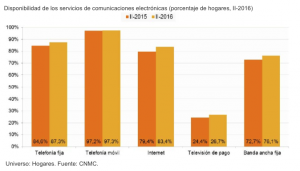
After more than 40 years of operation, DTVE is closing its doors and our website will no longer be updated daily. Thank you for all of your support.
Spain sees growth in pay TV and smart TV penetration
 Pay TV penetration in Spain has grown by 10% over the last year, while 28% of the country’s installed base of TVs are now connected to the internet, up 17.3%, according to figures released by the country’s competition regulator, the CNMC.
Pay TV penetration in Spain has grown by 10% over the last year, while 28% of the country’s installed base of TVs are now connected to the internet, up 17.3%, according to figures released by the country’s competition regulator, the CNMC.
According to the CNMC, 26.7% of Spaniards said they took pay TV at the end of the second quarter of this year, up from 24.4% a year ago.
Some 47.1% of pay TV subscribers said they took a pay services because their operator provided it along with other services such as broadband and telephony – the highest rated reason for taking pay TV.
Some 35.3% said they took pay TV because the were interested in particular series channels, while 30.5% said they were interested in sports content.
Some 25.3% said they took pay TV because there were interested in documentary channels, with 24.2% saying they liked pay TV because it offered a way to view fewer TV ads.
About 23.4% said pay TV offered the chance to catch recently-rele3ased movies, while 13.1% said that they were interested in offers with kids content, and 6.6% said they were interested in international news channels.
According to the regulator, 83.4% of Spanish homes had an internet connection in June, up 5%. Fixed-line internet penetration stood at 76.1%, with 36.2% having a fibre connection.
According to the numbers reported by the CNMC, 52% of internet homes reported having an ADSL of VDSL connection, down from 65.8%, while the number with a fibre connection increased from 22.8% to 36.2%. Those reporting a cable broadband connection numbered 12.7%, down from 15.8%.
The number of homes reporting that they had quintuple-play services – fixed and mobile phones, fixed and mobile internet and pay TV – at the end of June numbered 68.7%, up from 62.8%, while the number with a quad-play service – without mobile internet – numbered 47.8%, up from 46.2%.
The CNMC surveyed a panel of 4,685 households with 9,317 individuals.


